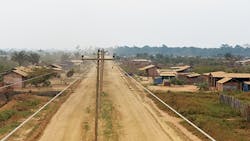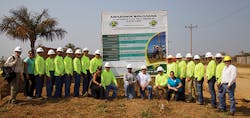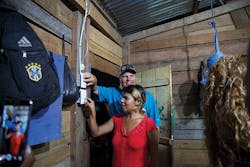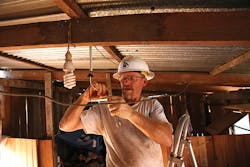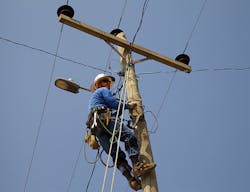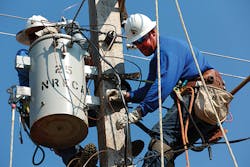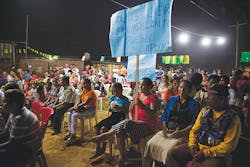Away from home for 17 days, tired linemen from the United States sit together to enjoy one last meal in Santa Cruz, Bolivia. Loud laughs, jokes and an amusing phone conversation with Ramiro Suez, the team’s bus driver, show the brotherhood and camaraderie around the table. Back at the hotel, their bags are packed and tools put away. They have had a challenging and fulfilling journey.
The linemen spent more than two weeks in Bolivia building power lines to electrify two remote villages. It was an unforgettable experience to see the sparkle in the eyes of the villagers who turned on the lights for the first time. Now, with a sense of fulfillment and the mission accomplished, they are ready to return home and hug their families.
Making a Difference
Most of the villagers lived with little in the form of material possessions, and they had no electric appliances. At times, the team wondered what one lightbulb could do. Would it really make that big of a difference? Then they would think about the children in the villages doing their homework by candlelight, and how, when the light switch was turned on at the first house, the bulb brightened the entire home. At that moment, it was clear one lightbulb makes a difference. It makes a big difference!
The first home wired to receive power in the village of Dos de Junio belonged to Carlos and Noemi Chatari, who are deaf and mute. To them, and to the other 360 families impacted by this project, one lightbulb makes a world of difference — just like it did in rural America 80 years ago, when rural electric cooperatives were formed.
Project Coordination
With coordination from NRECA International, the philanthropic arm of the National Rural Electric Cooperative Association (NRECA), the Oklahoma Association of Electric Cooperatives (OAEC) and the Association of Missouri Electric Cooperatives took on a joint project to electrify the villages of El Torito and Dos de Junio in the Amazonian area of Bolivia. Funded by the electric cooperatives, this project was dubbed Energy Trails.
The villages are in the outskirts of Riberalta, a city of 90,000 inhabitants with one local electric cooperative, Cooperativa Electrica Riberalta (CER), providing electricity. Sixteen volunteers from Oklahoma and Missouri tackled the project to expand CER’s service. The project consisted of installing 280 poles over a span of 10 miles (16 km) of line with 3.5 miles (5.6 km) consisting of three-phase primary line and 6.5 miles (10.5 km) of secondary line. Missouri volunteers conducted wiring of the homes. Each home received one lightbulb per room and two electrical outlets.
The local linemen assisted the U.S. volunteers with the project. The younger CER linemen were fascinated by the streamlined processes of building lines, as demonstrated by the U.S. volunteers. CER linemen were instrumental in the preparation stage of the project. Prior to the volunteers arriving, local linemen had dug holes and installed 280 poles by hand. Volunteer linemen from Oklahoma and Missouri were impressed by the perfectly hand-dug holes. CER’s Director of Operations Eligio Villarroel told the volunteers it would have taken the cooperative five years to do the work the volunteers did in two weeks because of the lack of resources, funding and personnel time.
Local Conditions
The project was slated to take place in August 2016, which is winter and a dry season in Bolivia. Volunteers expected temperatures to be 70°F to 80°F (21°C to 27°C), but the average temperature was 96°F (35°C), causing manual labor to become more challenging. The relentless amount of dirt was another obstacle. High winds and dry village terrain caused extremely dusty conditions, at times resembling the Dust Bowl days of the 1930s in the U.S. prairies. At the end of a day’s work, the linemen, the trucks and their belongings were covered in dust.
The linemen also were challenged by the smell. Because of the inadequate sewage systems, villagers burned their trash daily. Dead animals also were burned, causing an unusual odor in the air.
It was noted the quality of the poles in Bolivia was significantly lower than the poles the volunteers were used to climbing at home. The poles were smaller and rougher. If home quality was a 10, the Bolivia quality was a three. Still, the U.S. linemen came physically prepared for the task.
Another challenge the crew faced was a four-day delay in the delivery of a crate of power tools they had shipped to Bolivia to assist them in their work. The local electric cooperative did not own bucket trucks, digger trucks or power tools. Volunteers had to keep moving forward despite the delay to complete the project within the allotted time.
Energy Trails
Larry A. Cisneros, a professional engineer and manager of engineering at Northeast Oklahoma Electric Cooperative, was part of the Energy Trails team. His role in the project was to provide technical assistance to the engineering department at CER. When arriving in Bolivia, he was surprised to learn CER was expecting the volunteers to bring engineering software to assist with system modeling and coordination. With a desire to help and an understanding of network modeling and analysis, Cisneros contacted Milsoft Utility Solutions, which offers an engineering and operations system for electric utility planning, analysis and operation.
Milsoft generously offered a 30-day student trial version so the cooperative could experience basic modeling and analysis. With only a limited amount of time in Bolivia, Cisneros realized more work and time would be needed for the software to be most effective. He created the cooperative’s base model in Milsoft while on site in Bolivia, with plans to verify the model when he returned home to Oklahoma. CER plans to email him other data elements so he can run an analysis to assist with some issues they are encountering. The Bolivian utility soon hopes to purchase the software, along with the needed training, as finances allow.
Cisneros’ first language is Spanish, which assisted him significantly during his interaction with local cooperative engineering personnel. Still, picking up technical engineering terms in Spanish was a challenge for this seasoned engineer. Part of his time with the cooperative’s engineering department included discussions on grounding as well as construction practices.
One of Cisneros’ eye-opening experiences was that the entire member base received power from one substation with four feeders and newly installed reclosers. Also, there was no training or instruction given to CER personnel on programming or interrogating these newly installed ABB PCD2000 recloser controls. Cisneros’ previous cooperative experience with this type of recloser controls was invaluable as he trained one of the cooperative’s engineering technicians on navigating through recloser controls to retrieve metering, operational and fault data.
The long-lasting impact for him will be the relationships formed during those two weeks. Cisneros developed friendships with CER engineering technicians and a respect for the challenges they face as a culture and a cooperative.
Inauguration Day
On Aug. 14, 2016, CER invited residents to a ceremony to formally turn on the lights. NRECA International representatives, NRECA Board Officer and Roanoke Electric Cooperative CEO Curtis Wynn, OAEC General Manager Chris Meyers and officials from CER were present at the ceremony along with volunteers from Missouri and Oklahoma’s electric cooperatives.
A stage was set up in the middle of a street in Dos de Junio and a string of lightbulbs was hung from one pole to another. The atmosphere was that of celebration, with loud Bolivian music and many smiles. The village residents were holding signs of appreciation for both NRECA and CER. Wynn spoke of a vision shared by electric cooperatives: the belief no person should live without the benefit of electricity. After remarks were made, CER officials turned on the lights. It was a moment of celebration for the locals.
A 50-year-old resident, Carmen Cardenas, said it was the first time in her lifetime she would have electricity. Cardenas has eight children who did homework by candlelight every evening. Her husband spends one month at a time away working the fields near the Amazonian forest, burning grass and preparing for Brazil nut harvest. She makes dust pans in her backyard to sell at the market for US$1.40. The future of Cardenas’ children will be impacted by access to electricity. She moved to Dos de Junio five years ago to acquire her first piece of land. Now, she is proud to say she also will enjoy electricity in her new home.
Safety has been a concern for residents of El Torito and Dos de Junio. Cardenas’ daughter Carmezita has been robbed while returning home from school. Carmezita is 22 years old and now completing the sixth grade. She works during the day as a housekeeper in Riberalta and attends school at night. Volunteer linemen were made aware that neither CER nor the local government had planned to install streetlights in Dos de Junio and El Torito because of the lack of resources.
To enhance safety in the villages, the volunteers took it upon themselves to buy streetlights. NRECA International and the local cooperative contributed to the funds to buy streetlights, as well. On the morning of Inauguration Day, they installed 11 streetlights in Dos de Junio and four in El Torito.
The Road Ahead
In time, CER will build more power lines to keep up with the expansion of the villages. The volunteers built a feeder line. As residents are able to purchase electric appliances and increase the energy consumption of their homes, the cooperative will need to upgrade the lines to meet a growing demand for power. But having one lightbulb right now will enhance their quality of life.
The volunteers said they experienced more change in themselves than the change they brought to the villages. The linemen went home with newly formed friendships and new perspectives. The trip has taken them back in time nearly 80 years to when power lines were built in rural America, where there had never been power before. In the 1930s and 1940s, rural electrification pioneers went door to door organizing cooperatives and performed all the labor by hand to make the gift of electricity a reality.
Acknowledgements
Special thanks to Larry Cisneros, professional engineer and manager of engineering at Northeast Oklahoma Electric Cooperative, based in Vinita, Oklahoma, U.S., and Anna Politano, certified cooperative communicator and editor of Oklahoma Living magazine, published by OAEC.
Wade Hurst serves as senior safety and loss control specialist for the Oklahoma Association of Electric Cooperatives. He served on the Southern Area Instructors Association board for the past six years, serving as chairman for one year. He currently serves as director of the National Utility Training & Safety Education Association board. Hurst studied business at Oklahoma Wesleyan University. He was previously employed as line foreman at Cookson Hills Electric, based in Stigler, Oklahoma, U.S.
